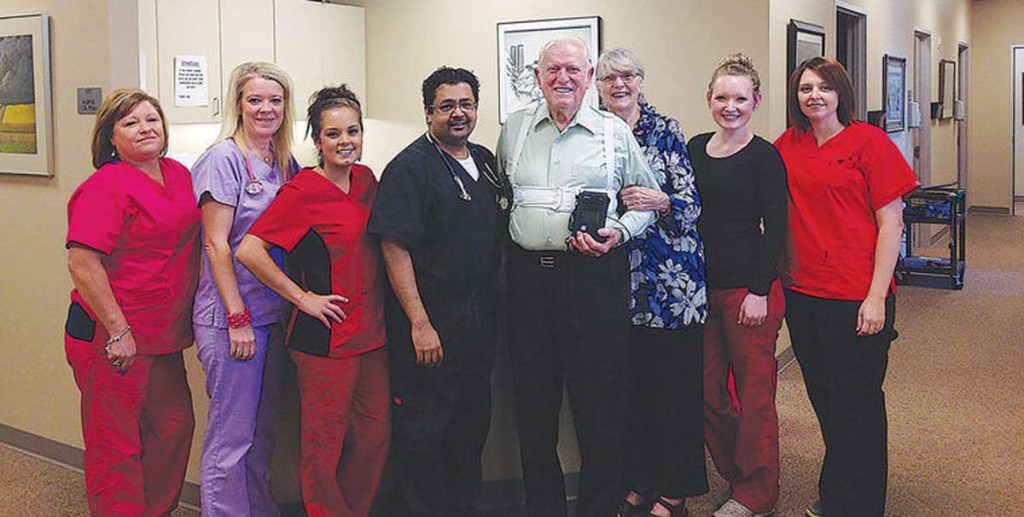Wearable defibrillator saves life of Texas man who “pretty much died” in his sleep
Published 9:35 am Saturday, August 29, 2015

- Charles Allen, center, stands with his wife, Dr. Guarav Aggarwala and his staff on Tuesday. Allen would not be standing for this photo if it weren’t for the LifeVest Aggarwala prescribed for him.
According to his doctor Charles Allen of Grapeland, Texas essentially died in his sleep and woke up to tell about it. That was on July 26. Had the sudden cardiac arrest happened before July 23, he’d still be dead.
That was the day the 83-year-old’s cardiologist, Dr. Guarav Aggarwala, prescribed him a LifeVest, a wearable defibrillator that can and does save lives by shocking the heart back into rhythm upon detecting arrhythmia. Blue gel (for conduction as well as protection), releases onto the back. A voice preps you for the procedure. Moments later, you have a new (if temporary) lease on life. After the shocks, wearers are instructed with a recording to immediately seek medical attention.
Thanks to an earlier heart attack that damaged his heart muscle, Allen was casebook candidate for the tight-fitting, high-tech addition to his wardrobe, which wears every day under his shirt.
Aggarwala has been recommending the LifeVest, which first went on the market in 2001, to patients for six years.
“It’s the best thing out there,” Aggarwala said. “Patients who suffer from really bad heart disease and really weak hearts need to be protected from something called Sudden Cardiac Death. Medicare and insurance companies have guidelines on how long you have to wait to implant a permanent defibrillator. So in that bridge period, there is no other alternative, but to leave things to fate or turn to a wearable defibrillator.”
According to Zoll, the company that manufacturers the LifeVest, “tens of thousands” of the vests are in use on any given day across the world.
The device has been making recent headlines for keeping users alive, several of which, like Allen, strapped in just in time.
Earlier this month in Tyler, Texas, the life of 61-year-old Dwain Spradlin was saved by a LifeVest, one of nearly 50 his cardiologist, Dr. Christopher Boylan, has ordered for his patients.
“The next thing I knew I was waking up on the garage floor. And I hear this siren that’s going off and this voice saying, ‘You’ve been treated, you need to contact your doctor,'” Spradlin told WCAX.
“The life vest did save his life,” Boyland said. “And if he had not had the life vest on, he likely would have died due to ventricular fibrillation.”
Late last year, just one month after he was fitted for a LifeVest, Dennis Young of Greenville, South Carolina suffered cardiac arrest and collapsed on his porch, ironically while waving to the home health nurse driving up to his house.
“I’d seen her up the hill, waved at her,” Young told USA Today. “And that’s the last thing I knew until she was on the steps and asking me if I was all right.”
Thanks to his LifeVest, he was, and he can’t say good enough things about it.
Neither can Aggarwala, the latest doctor to witness a nick-of-time LifeVest success story, who even after six years still marvels at the vest’s sophistication.
“It has really sensitive heart monitors,” Aggarwala said. “If an abnormal heart rhythm is detected, the vest will beep to see if you are conscious. If you are conscious and able to respond, you will press and hold the respond buttons on the device to prevent a treatment shock. If your heart goes into a life-threatening rhythm, you will be unconscious and not able to respond. The vest then delivers a treatment shock to the patients heart in order to restore the rhythms to normal.
“In case of Mr. Allen. It was very clear cut. By all standards he pretty much died and was resuscitated by the shock.”
Details for this story were provided by the Palestine Herald-Press.




